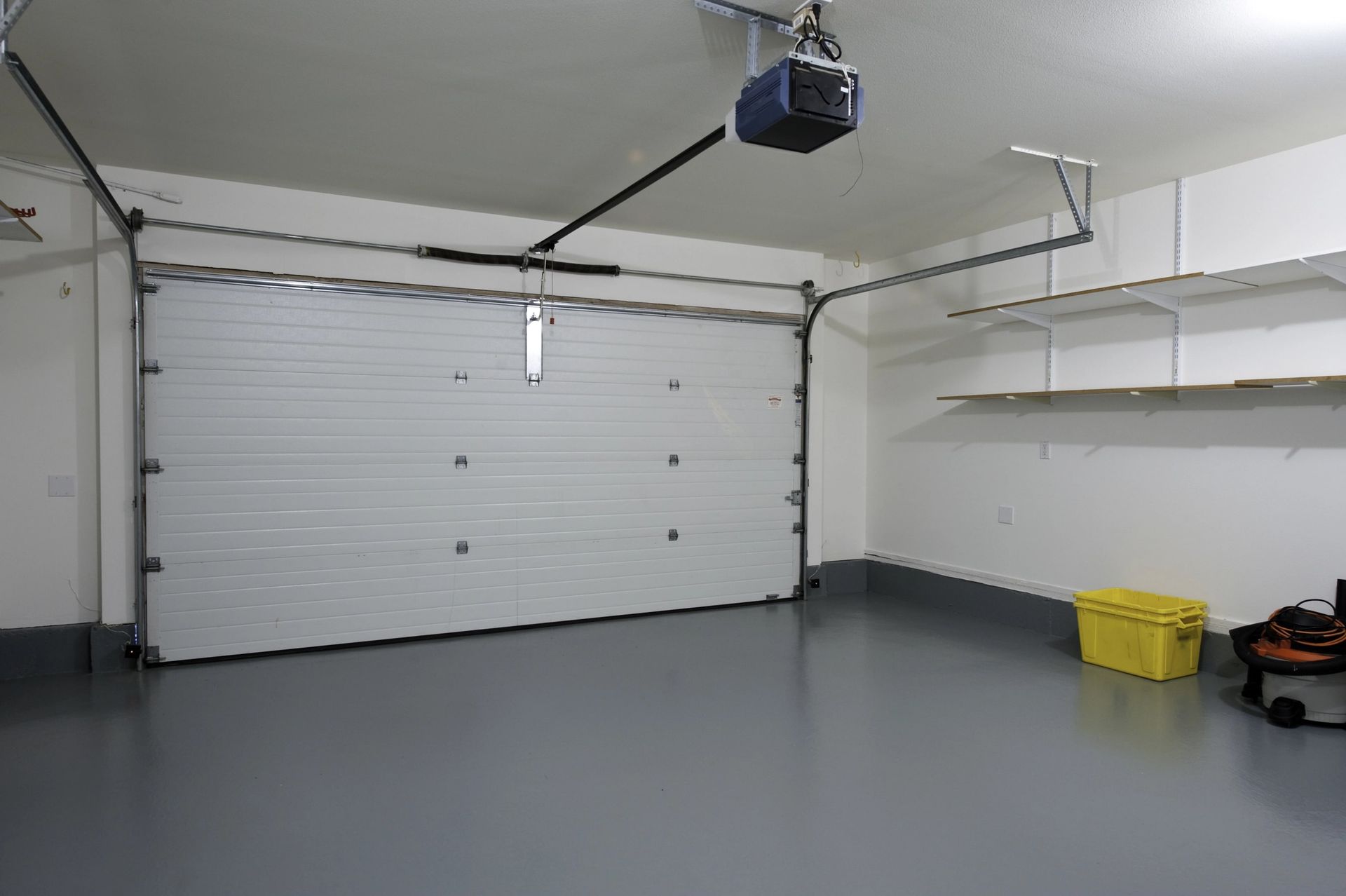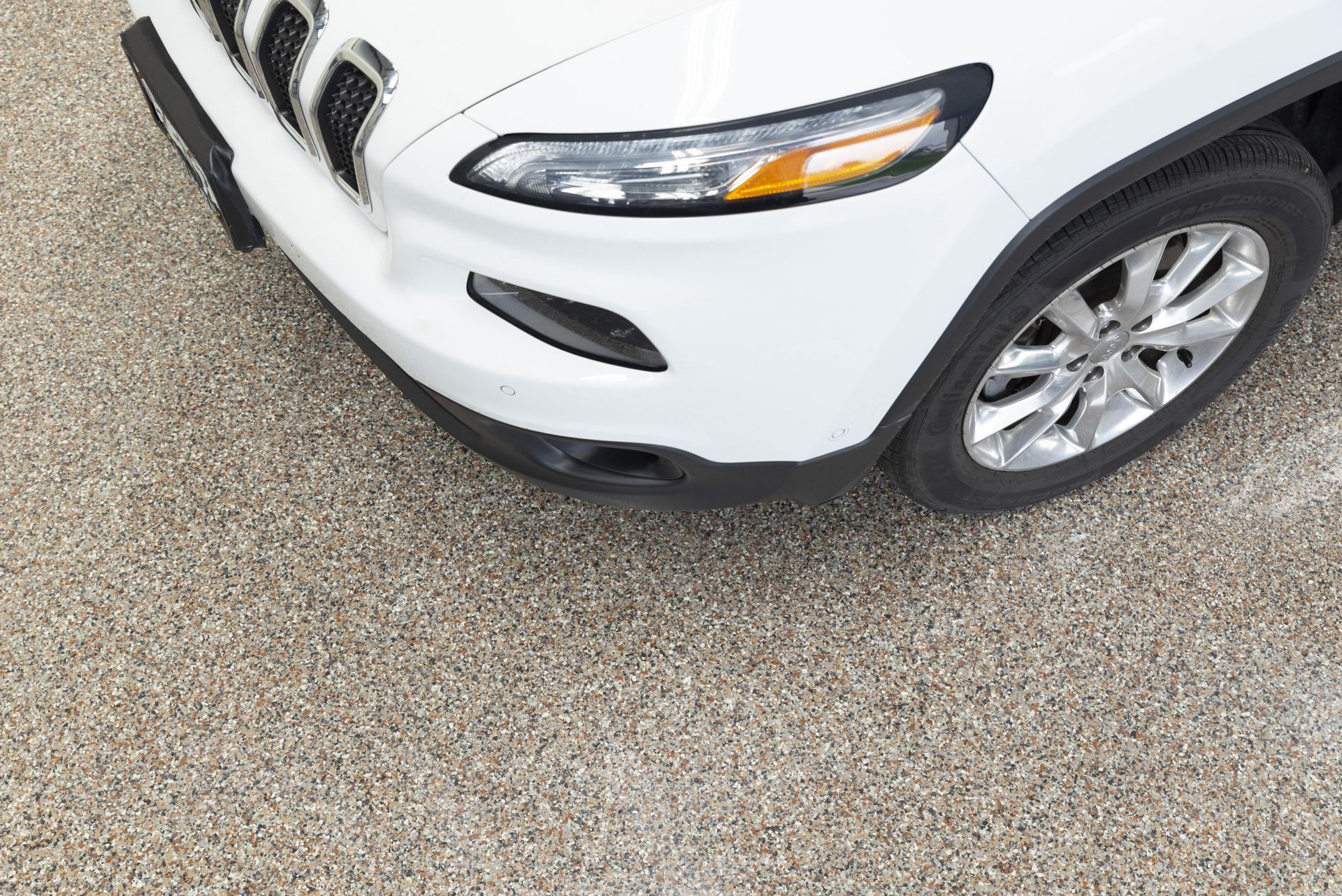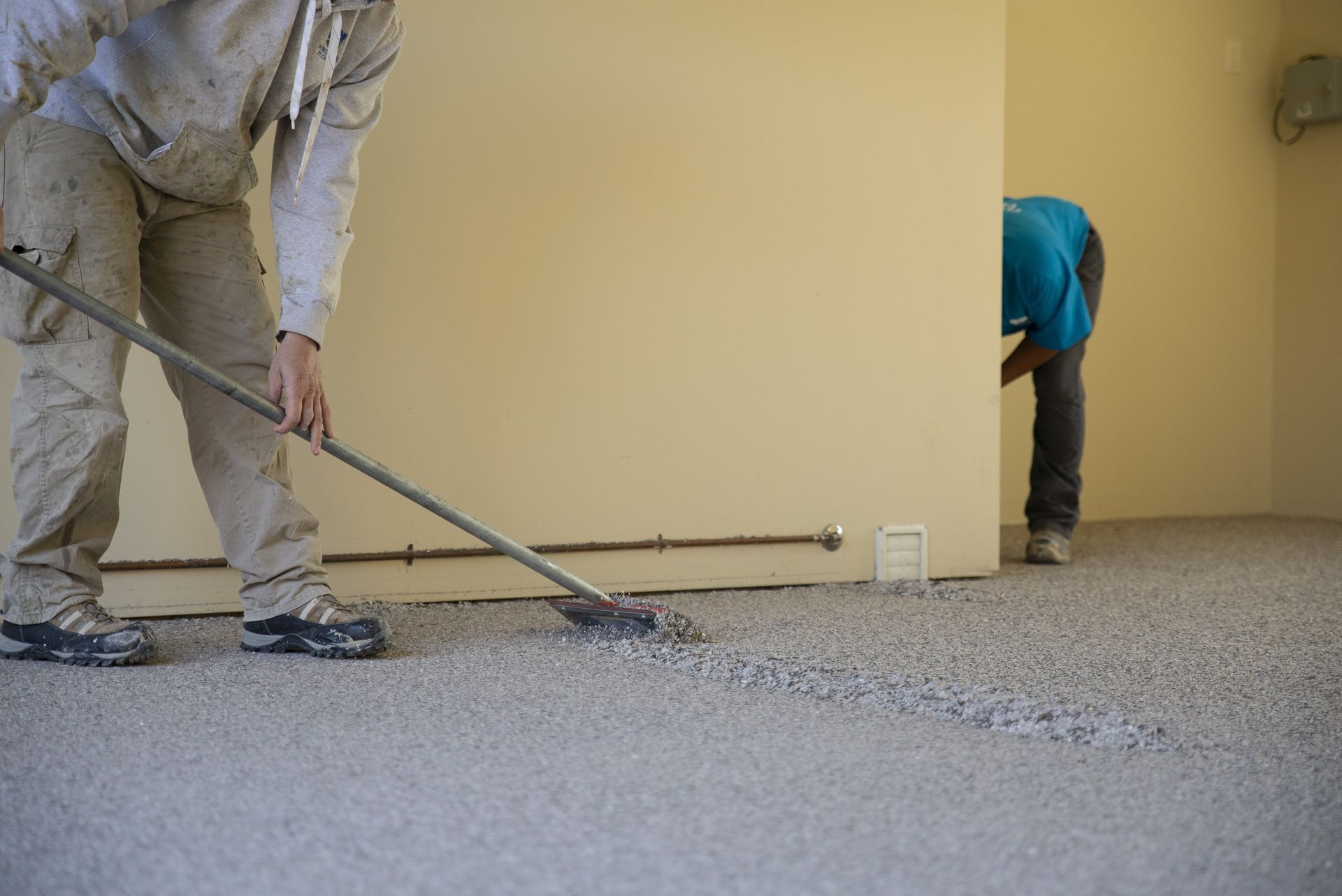Blog

15 May, 2024
When you think of floor coatings, you likely envision sleek garage floors or industrial settings. From residential spaces to commercial establishments, innovative uses of floor coatings are revolutionizing interior design and functionality. In this blog post, we'll explore some creative and unexpected ways to use floor coatings, inspiring you to think outside the box for your next project. Creative Flooring Designs: Floor coatings offer endless possibilities for creating custom flooring designs that reflect your unique style and personality. Whether you're looking to replicate the look of natural stone, hardwood, or decorative tiles, floor coatings can be customized to mimic virtually any surface. From intricate patterns to bold color combinations, the only limit is your imagination. Consider incorporating decorative elements such as stencils, stamps, or metallic accents to add visual interest and dimension to your floors. Artistic Murals and Graphics: Floor coatings provide a blank canvas for showcasing artistic murals and graphics that add character and charm to any space. Whether you want to transform a plain concrete floor into a vibrant work of art or create a whimsical scene in a children's playroom, floor coatings offer the perfect medium for unleashing your creativity. From abstract designs to intricate illustrations, the possibilities are truly endless. With the right techniques and materials, you can achieve stunning results that are sure to impress. Outdoor Living Spaces: Floor coatings aren't just for indoor use—they can also be used to enhance outdoor living spaces such as patios, decks, and pool surrounds. By applying a durable, weather-resistant coating to outdoor surfaces, you can create a seamless transition between indoor and outdoor areas while adding beauty and functionality to your outdoor living space. Choose from a wide range of colors, textures, and finishes to complement your outdoor decor and landscaping. Commercial and Retail Environments: In commercial and retail environments, floor coatings can play a crucial role in branding, safety, and customer experience. Use floor coatings to create eye-catching logos, signage, or wayfinding markers that guide customers through your space. Incorporate non-slip coatings in high-traffic areas to enhance safety and prevent slips and falls. Choose durable, easy-to-clean coatings that withstand heavy foot traffic and maintain their appearance over time, ensuring a positive impression on customers and clients. Healthcare and Hospitality Settings: Floor coatings are ideal for healthcare and hospitality settings where cleanliness, durability, and aesthetics are paramount. In hospitals and medical facilities, seamless, non-porous floor coatings provide a hygienic surface that is easy to clean and disinfect, helping to reduce the risk of healthcare-associated infections. In hotels, resorts, and restaurants, decorative floor coatings can create a welcoming atmosphere that enhances the overall guest experience. Choose coatings with antimicrobial properties for added protection against germs and bacteria. DIY Projects and Home Improvement: Floor coatings aren't just for professional installers—DIY enthusiasts can also take advantage of their versatility and ease of use. Whether you're updating your basement floor, refinishing your patio, or revamping your garage, floor coatings offer a cost-effective, DIY-friendly solution for transforming your space. With a bit of preparation and the right tools, you can achieve professional-looking results that rival those of a professional installer. In conclusion, the innovative uses of floor coatings extend far beyond traditional applications, offering endless possibilities for creativity and customization. Whether you're looking to create custom flooring designs, showcase artistic murals, enhance outdoor living spaces, or elevate commercial environments, floor coatings provide a versatile and durable solution that meets your needs. If you're ready to think outside the box and explore the potential of floor coatings for your next project, contact Brookhaven Garage Floor for expert advice and professional installation services. We're here to help you bring your vision to life and transform your space with innovative floor coatings that enhance both aesthetics and functionality.

08 May, 2024
Applying a fresh coat of floor coating can transform the look and functionality of your space, whether it's a garage, workshop, or commercial facility. In this blog post, we'll delve into the intricacies of the drying and curing process of floor coatings, providing valuable insights into what to expect during each stage. Drying vs. Curing Before we dive into the specifics, let's clarify the difference between drying and curing. Drying refers to the process by which solvents or water evaporate from the coating, leaving behind a dry surface. Curing, on the other hand, involves a chemical reaction that occurs between the coating and the surrounding air, resulting in the formation of a strong, durable bond. Initial Drying Phase After the floor coating is applied, the initial drying phase begins. During this stage, solvents or water in the coating evaporate, leaving the surface tack-free to the touch. Depending on the type of coating and environmental conditions, this phase typically takes anywhere from a few hours to a day or more. It's essential to allow adequate drying time before walking or placing objects on the coated surface to prevent damage or blemishes. Curing Process Once the initial drying phase is complete, the curing process begins. This stage involves the chemical reaction between the coating and the surrounding air, resulting in the formation of cross-links that give the coating its strength and durability. Curing times can vary depending on factors such as temperature, humidity, and the type of coating used. In general, full curing may take several days to a week or more. Temperature and Humidity Considerations Temperature and humidity play significant roles in the drying and curing process of floor coatings. Ideally, the ambient temperature should be within the manufacturer's recommended range for optimal drying and curing. High temperatures can accelerate drying and curing but may also lead to premature skinning or bubbling of the coating. Conversely, low temperatures can slow down the process and affect the quality of the finish. Similarly, humidity levels should be moderate to prevent moisture-related issues such as blushing or adhesion failure. Ventilation and Air Circulation Proper ventilation and air circulation are crucial during the drying and curing process to facilitate evaporation of solvents or water and promote uniform curing. Ensure that the space is well-ventilated by opening windows or using fans to circulate air. Avoid sealing off the area or trapping moisture, as this can prolong drying and curing times and compromise the quality of the finish. Avoiding Premature Use It's essential to exercise patience and avoid premature use of the coated surface during the drying and curing process. Walking, driving, or placing heavy objects on the floor before it's fully cured can result in damage, marring, or adhesion issues. Follow the manufacturer's recommendations for curing times and avoid heavy traffic or excessive wear until the coating has fully cured. In conclusion, understanding the drying and curing process of floor coatings is essential for achieving optimal results and ensuring the longevity of your investment. By familiarizing yourself with the stages of drying and curing, considering temperature and humidity conditions, promoting ventilation and air circulation, and avoiding premature use, you can enjoy a beautifully coated floor that withstands the test of time. If you're considering coating your garage floor or other surfaces, contact Brookhaven Garage Floor for expert advice and professional installation services. We're here to help you transform your space with high-quality floor coatings that enhance both aesthetics and functionality.

02 May, 2024
With the right floor coating and color choice, you can transform your garage into a stylish and inviting space that complements your home's aesthetic. Selecting the perfect color for your floor coating is an important decision that can enhance the overall look and feel of your garage. In this blog post, we'll explore some tips for choosing the right colors for your floor coatings to match your style and create a cohesive design scheme. Consider Your Existing Décor When selecting a color for your garage floor coating, it's essential to consider the existing décor and design elements in your home. Take note of the colors, patterns, and materials used in adjacent rooms and choose a floor coating color that complements or enhances these features. For example, if your home has a modern, minimalist style with neutral color palettes, consider opting for a sleek, monochromatic floor coating in shades of gray or beige. Alternatively, if your home features bold colors or eclectic décor, you may want to choose a floor coating color that adds contrast or complements these elements. Reflect Your Personal Style Your garage is an extension of your home, so it's essential to choose a floor coating color that reflects your personal style and preferences. Whether you prefer a classic, timeless look or a more contemporary, trendy vibe, there are floor coating colors available to suit every taste. If you're drawn to classic design aesthetics, consider opting for neutral colors such as white, beige, or gray for your garage floor coating. These versatile shades provide a clean, timeless backdrop that pairs well with a variety of design styles and décor choices. On the other hand, if you're looking to make a statement and add personality to your garage, don't be afraid to experiment with bolder colors and finishes. Consider vibrant hues like blue, red, or green to infuse your space with energy and personality. You can also explore decorative options such as metallic flakes or decorative chips to add texture and visual interest to your garage floor. Think About Functionality While aesthetics are important, it's also essential to consider the functionality and practicality of your garage floor coating color. Lighter colors such as white or beige can help brighten up the space and make it feel larger and more open, which can be beneficial if you use your garage as a workshop or storage area. However, it's essential to keep in mind that lighter colors may show dirt, stains, and tire marks more easily than darker colors. If you're concerned about maintenance and upkeep, you may want to opt for a darker floor coating color such as charcoal gray or black, which can help conceal imperfections and maintain a clean appearance over time. Seek Inspiration If you're feeling overwhelmed by the multitude of color options available for garage floor coatings, seek inspiration from design magazines, websites, and social media platforms. Create a mood board or Pinterest board to gather images of garage spaces that resonate with your style and preferences. Pay attention to color palettes, patterns, and design elements that catch your eye, and use them as a starting point for selecting the perfect floor coating color for your garage. You can also consult with design professionals or flooring experts for personalized recommendations and guidance based on your specific needs and preferences. Test Samples Before committing to a floor coating color for your garage, it's essential to test samples in your space to see how they look in different lighting conditions and against your existing décor. Many manufacturers offer sample kits or swatches that allow you to see how various colors and finishes will appear on your garage floor. Take the time to test multiple samples and observe how they interact with natural and artificial light throughout the day. Consider how each color complements your garage's architecture, furnishings, and other design elements, and choose the one that best achieves the look and feel you desire. Conclusion Choosing the right color for your garage floor coating is a crucial step in creating a functional and stylish space that reflects your personality and complements your home's aesthetic. By considering your existing décor, personal style, functionality needs, and seeking inspiration from design resources, you can select a floor coating color that enhances the overall look and feel of your garage. With careful consideration and attention to detail, you can transform your garage into a welcoming and visually appealing space that you'll be proud to show off to family and friends.

23 Apr, 2024
Whether you have a patio, deck, or garage floor, maintaining your coated surfaces is essential for preserving their beauty and durability. In this blog post, we'll share some valuable summer maintenance tips to help you keep your coated outdoor spaces looking great all season long, brought to you by Brookhaven Garage Floor. 1. Regular Cleaning Regular cleaning is key to preserving the appearance and longevity of your coated outdoor surfaces. Sweep away dirt, debris, and leaves regularly to prevent scratches and abrasions. For deeper cleaning, use a mild detergent and water solution to gently scrub the surface. Avoid harsh chemicals or abrasive cleaners, as they can damage the coating and compromise its integrity. 2. Preventative Measures Prevention is better than cure, especially when it comes to outdoor maintenance. Place mats or rugs at entry points to capture dirt and moisture before they reach your coated surfaces. Use furniture pads or coasters to prevent scratching and gouging from heavy patio furniture. Consider adding a protective sealant or topcoat to enhance the durability of your coating and provide an extra layer of protection against UV rays and harsh weather conditions. 3. Address Stains Promptly Accidents happen, and spills are inevitable, especially during summer gatherings and barbecues. Address stains promptly to prevent them from setting into the coating. Blot spills with a clean cloth or paper towel as soon as they occur, then gently clean the area with a mild detergent and water solution. For stubborn stains, you may need to use a specialized cleaner or degreaser recommended by your coating manufacturer. 4. Maintain Proper Drainage Proper drainage is essential for preventing water damage and prolonging the life of your coated outdoor surfaces. Ensure that your patio, deck, or garage floor has adequate drainage to prevent standing water from pooling and causing discoloration or deterioration of the coating. Clean out gutters and downspouts regularly to prevent water from overflowing onto your coated surfaces during heavy rainstorms. 5. Avoid Heavy Traffic Minimize heavy foot traffic and vehicular traffic on your coated outdoor surfaces, especially during hot summer days when the coating is more susceptible to damage. Encourage guests to use designated walkways and parking areas to reduce wear and tear on the coating. Consider placing protective mats or pavers in high-traffic areas to distribute weight and prevent indentations. 6. Schedule Regular Inspections Finally, schedule regular inspections of your coated outdoor surfaces to identify any signs of wear, damage, or deterioration early on. Look for cracks, chips, peeling, or discoloration that may indicate underlying issues with the coating. Addressing these issues promptly can help prevent further damage and extend the life of your coating. Don't let summer take a toll on your coated outdoor surfaces. Follow these maintenance tips to keep your floors looking great year-round.
LET'S CONNECT!
Ensure the longevity and aesthetics of your garage floors with Brookhaven Garage Floor! Our expert team excels in transforming mundane garage and basement floors into remarkable spaces using resilient polyurea and polyaspartic coatings. Customized to suit your requirements, our coatings seamlessly blend functionality with style. Rely on Brookhaven Garage Floor to revitalize your floors today!
© 2024
All Rights Reserved | Brookhaven Garage Floor